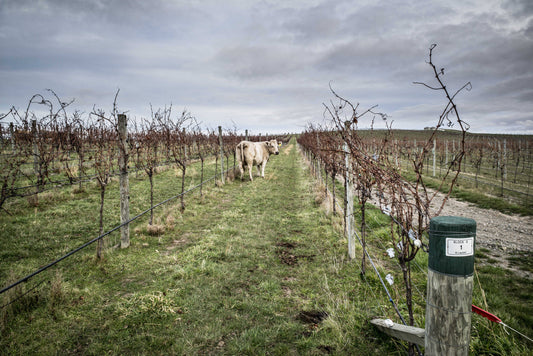| For Burgundy, 2021 was a year in danger of being remembered for all the wrong reasons. Many wine lovers will have seen the newspaper photographs of pitch-black vineyards illuminated with fires designed to stave off the devastating April frosts, but few can imagine the atmosphere at the time. ‘I remember all the lights, all the fires burning, especially in the Corton Les Renardes, where I went to see my friend…it was below zero. You could sense the fear of the loss of the whole crop in one morning’, says Arnaud Orsel, intendant général of the Confrérie des Chevaliers du Tastevin, an organization that celebrates and promotes Burgundy’s wines worldwide. ‘The feeling was not only in the winemakers, but most of the inhabitants also felt this kind of pressure that the vintage might not happen, and that we need to fight.’ |
| Fighting against the elements is, to understate matters, far from easy, and in places like Corton-Charlemagne almost 90 percent of the buds were burned by sun and frost. A cool, wet summer followed – something by no means atypical for this cool-climate region – followed by a sunny September and late harvest. ‘Where we are in the Château du Clos de Vougeot, we saw almost 20 days difference between the first and and the last growers to harvest in the vineyards around us,’ remembers Orsel, who praises 2021 as a millésime of both the vigneron and the viticulteur. Intensive sorting of the grapes was vital this year, compounding the low quantities of fruit available for vinification. This was particularly prevalent at the Grand Cru level and, as Chardonnay has an earlier budburst, across the whites. As such winemakers – who from some plots could have made little more than a 114-litre feuilette – have often chosen to use their higher-rated grapes in Villages-level wines, or to vinify multiple plots as, for example, a Meursault Premier Cru blend. While this might make life more challenging to devotees of particular climats, the fact that a chunk of Premier Cru grapes might be lurking in your bottle of Côte de Beaune Villages offers great potential value in a vintage whose prices are trending towards a 10–25 percent increase on the previous year. Given the low yields and an increased demand for grapes from new winemakers entering the region, these prices are by no means a surprise, but it’s also worth remembering that the final bottle cost has also been raised by a tumultuous world picture that affected the availability of dry goods – not just bottles and capsules, but even the wooden pallets used in transportation are now three times as expensive. Price rises pose challenges for the region as well as the consumers, as Orsel explains. ‘We have a lot of very nice appellations like Mâcon and Marsannay, for example, served in restaurants and brasseries which represent Bourgogne very well. And if it’s more difficult to find them, they might be replaced with wines from other regions which are more accessible pricewise, so there might be a shift in the drinking of burgundy wine.’ |
| Getting burgundy onto the table is very much the raison d’etre of the Confrérie. The Château de Clos de Vougeot, which is also the home of the UNESCO world heritage site Climats de Bourgogne, opens between 20-25,000 bottles of burgundy every year across a wide range of events. For this organization, 2021 wasn’t just defined by frost – as was every wine region – but by the ongoing pandemic and its effect on tourism and celebrations. The Château couldn’t host large events, but it could encourage wine lovers to visit in other ways. ‘For us 2021 was also a singular year because of Covid and we had to think about new ideas to keep being alive’ remembers Orsel. ‘We created some new proposals for oenotourism, especially a lunch visit and tasting of Bourgogne wines in the Chateau, called La Table de Léonce.’ This experience, which costs 75 euros per person, proved so successful that the Château has added it to its regular offering. When wine lovers taste the 2021 wines at the Château or elsewhere, they’ll find a vintage that can shine just as brightly as those vineyard fires. The intensive grape sorting in September combined with, in general, a reduced level of whole-bunch fermentation, leads towards a vintage that offers ripeness, structure and plenty of fruit as well as, in the reds, pretty and well-integrated tannins. This is not to say that the wines lack a lean, racy side: the acidity is, unsurprisingly, still high, and many have a mouth-watering freshness that contributes to an immediacy of pleasure even at this early stage. While each producer was impacted by 2021’s weather differently, the unifying theme of the vintage is the purity of their results, as Orsel observes. ‘Obviously, for me one of the interesting domaines to look at, where you’re able to see the overall tendency of the vintage, is the Hospices de Beaune, whose vineyards range from Mâcon to Chablis, with plots in the Côte de Nuits, Côte de Beaune, Meursault, Clos de la Roche, et cetera. I was very impressed by the wines for this vintage. I think they have a great character of the terroir and are very elegant.’ The firm sense of place these wines offer, something described by one winemaker as ‘being able to see the soil through the wine’, is marking 2021 as a classic vintage and one to remind Burgundy purists just why they fell in love with the region. There might not be a lot to go around, but what there is, is certainly worth fighting for. |
| Caroline Roddis has been writing about wines and spirits for more than a decade, both as a freelance writer for a wide range of lifestyle publications and as editor for global retailer The Whisky Exchange. |



